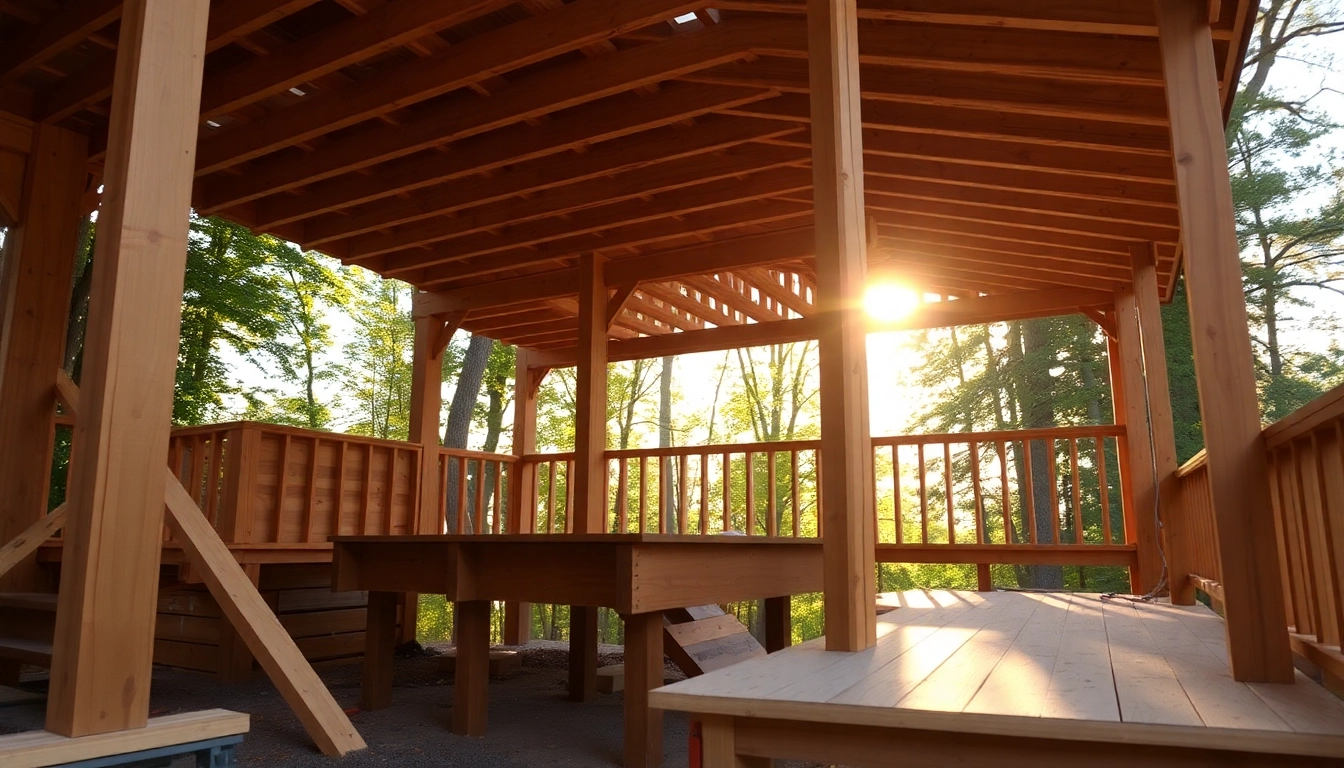Understanding Deck Construction
What is Deck Construction?
Deck construction refers to the process of building an outdoor platform typically made from wood or composite materials. Decks can enhance the aesthetic appeal of a home while providing functional outdoor living space for activities such as entertaining, dining, or simply enjoying nature. A well-constructed deck not only boosts a property’s curb appeal but also increases its value.
The Benefits of Building a Deck
There are numerous benefits to adding a deck to your home, including:
- Increased Living Space: A deck extends your home’s usable area, providing additional space for gatherings, relaxation, or outdoor activities.
- Enhances Property Value: Homeowners can expect a significant return on investment when selling their property, as a well-built deck can increase home value by as much as 10-15%.
- Improved Outdoor Aesthetics: A deck can enhance the beauty of your yard, allowing for the integration of landscaping features.
- Versatile Use: Decks can serve multiple purposes, including outdoor dining, barbecuing, or simply lounging in the sun.
Types of Decks: Wood vs. Composite
When it comes to deck construction, two primary materials are commonly used: wood and composite. Each offers distinct advantages and disadvantages.
Wood Decks
Traditionally, wood decks have been a popular choice due to their natural aesthetics and cost-effectiveness. Common hardwoods like cedar and redwood are favored for their resistance to decay, while pressure-treated pine is the most affordable option. However, wood decks require regular maintenance, including staining and sealing, to prevent warping and decay.
Composite Decks
Composite decking, made from a blend of wood fibers and recycled plastics, has gained popularity for its low maintenance requirements and durability. Although they tend to be more expensive than wood, composite decks do not splinter, rot, or require annual staining, making them a cost-effective option over time.
Planning Your Deck Project
How to Choose the Right Location
Choosing the right location for your deck is crucial for maximizing its use and enjoyment. Consider factors such as sunlight exposure, proximity to your home, views, and local zoning regulations. It’s also important to evaluate the slope of your yard, as a level surface will simplify construction.
Essential Tools and Materials for Deck Construction
Regardless of whether you hire a contractor or opt for a DIY project, understanding the tools and materials involved in deck construction is key. Essential tools include:
- Measuring tape
- Level
- Post hole digger
- Drill
- Circular saw
- Safety gear (gloves, goggles, etc.)
Materials will vary depending on your design and chosen materials but typically include:
- Decking boards (wood or composite)
- Joists and beams
- Fasteners (deck screws, bolts)
- Post anchors
- Concrete for footings
Understanding Local Building Codes
Before beginning construction, it’s essential to understand and comply with local building codes and zoning laws. These regulations dictate the size, height, and placement of decks to ensure safety and neighborhood compatibility. Check with your local building authority for proper permits and guidelines to avoid potential issues.
Step-by-Step Deck Construction Process
Preparing the Site for Construction
Proper site preparation is critical for successful deck construction. Start by clearing the area of debris, vegetation, and any obstacles. Measure and mark the layout of your deck, creating a clear outline for where the posts and beams will be located.
Framing Your Deck: Best Practices
The framing of your deck is what provides its structural integrity. Follow these best practices:
- Install Footings: Begin by digging post holes for the footings—these should extend below the frost line in your area. Fill the holes with concrete and insert post anchors while the concrete is still wet.
- Construct the Frame: Attach ledger boards to your house forming the structure’s perimeter. Use joists to support the surface or decking boards, ensuring they are level and spaced properly.
- Secure Beam Connections: Securely fasten beams to the posts, ensuring they are anchored and offer sufficient support for the deck surface.
Installing Decking and Railings
Once the frame is securely built, it’s time to install the decking boards. Follow these steps:
- Lay the Decking: Install the boards perpendicular to the joists, allowing for gaps between boards to account for expansion. Use deck screws for secure fastenings.
- Add Railings: If applicable, ensure your railings meet local height requirements and are sturdy enough to provide safety and support.
Common Deck Construction Challenges
Addressing Slope and Drainage Issues
Consideration of slope and drainage is vital in deck construction. Ensure that the deck does not block any natural drainage paths and address any low areas in your yard that may retain water. You may need to incorporate drainage systems to direct water away from the foundation.
Managing Weather Conditions During Construction
Weather can significantly impact your deck construction timeline. Work around rain and extreme temperatures by scheduling construction during milder weather conditions. Avoid working in wet conditions, as moisture can damage materials and compromise structural integrity.
Ensuring Structural Integrity
Before finishing, check all connections and joints to ensure your deck can withstand weight and environmental stresses. Use additional support where necessary and consult building codes for any specific structural requirements to bolster safety and longevity.
Maintenance Tips for Your Deck
Regular Cleaning and Inspections
Regular maintenance is important for ensuring your deck remains in great condition. Clean your deck annually to remove dirt, mildew, and debris that can cause damage. During inspections, look for any signs of structural wear, such as loose boards or rusty fasteners.
Sealing and Staining Your Deck
Applying a sealant or stain every few years helps protect wood from weather damage and UV rays. Ensure that the surface is clean and dry before applying sealant to ensure a proper bond and lasting protection.
Winter Preparation and Care
Before winter, ensure your deck is prepared to withstand harsh conditions. Clear any snow or ice that could cause damage and consider covering the deck to protect it from freezing temperatures and moisture. Regularly check the deck during winter to address any potential issues proactively.
Building a deck can enhance your home’s outdoor lifestyle and overall property value. Understanding the essentials of deck construction, from careful planning to effective maintenance, ensures a successful project and a beautiful, functional outdoor space for years to come.



